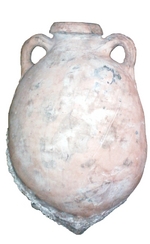Roman Amphorae: a digital resource
University of Southampton, 2005. (updated 2014) https://doi.org/10.5284/1028192. How to cite using this DOI
Data copyright © University of Southampton unless otherwise stated
This work is licensed under the ADS Terms of Use and Access.
Primary contact
Dr
David
Williams
Dept of Archaeology
University of Southampton
Avenue Campus
Highfield
Southampton
SO17 1BJ
England
Tel: 080 593032
Resource identifiers
- ADS Collection: 463
- DOI:https://doi.org/10.5284/1028192
- How to cite using this DOI
Dressel 23

Courtesy of Musée Archaéologique Intercommunal d’Istres
David Williams
Distinctive FeaturesThis type is a smaller version of late Dressel 20 type. Martin-Kilcher (1983; 1994) demonstrates the evolution of this type from Dressel 20. Keay (1984) divided it into five variants (Keay 13A-E) and one related type (Keay 13Bis), primarily based on rim variants. Berni (1998) created a new classification that draws a clearer picture of all these types, provided under 'Drawings'. The type generally features a short triangular rim just beneath which are two small oval handles, a bulbous, lemon-shaped body and a short spike. It is occasionally stamped towards the summit of the handle.See characteristics | ||
Date RangeOriginally thought to date from the third to fourth centuries AD (Beltrán, 1970; Manacorda, 1977a; Berni, 1998), excavations at Lyon, Arles and Marseille have yielded examples dating to between the late fifth and early sixth centuries AD (Becker et al., 1989; Bonifay & Piéri 1995).Search: [3rd century AD] [4th century AD] [5th century AD] [6th century AD] | ||
OriginSame area of origin as Dressel 20, with production attested at many kiln sites along the river Guadalquivir and its tributaries between Seville and Córdoba (Beltrán Lloris, 1970; 1978; Manacorda, 1977a).Search: [North West Europe] [Spain] [Western Mediterranean] | ||
DistributionSpain, Portugal, France, Italy, Germany and Algeria (Beltrán Lloris, 1970; Manacorda, 1977a; Beltrán Lloris, 1983; Keay, 1984; Fabião, pers.comm.). Also found in Scythia at Murighiol and Topraichioi (Opaiţ, 1996: 226).Search: [Black Sea] [Central Europe] [France] [Germany] [Great Britain] [Italy] [North Africa] [North West Europe] [Portugal] [Spain] [The Balkans] [Western Mediterranean] | ||
ContentsInscriptions suggest olive-based products (Beltrán Lloris, 1970; Keay, 1984, Rodríguez Almeida, 1984) such as olive oil and possibly olives (CIL XV.4803 and CIL XV.4804).Search: [Olive Oil] [Olives] | ||
CommentsPrincipal contributor: César Carreras | ||
ClassificationDressel 23Keay 13A Peacock & Williams 26 | ||
CEIPAC linkThe following link will take you to the Centro para el Estudio de la Interdependencia Provincial en la Antiguedad Clásica CEIPAC database. In the CEIPAC system this amphora has the ID KE51+BYZ. Note: access to CEIPAC requires registration, which is possible via http://ceipac.ub.edu/corpus_reg.php?IDM=e | ||



 3D models
3D models


